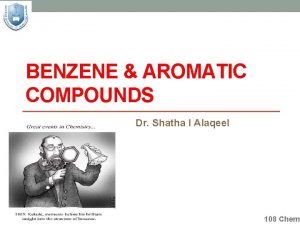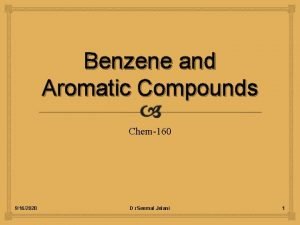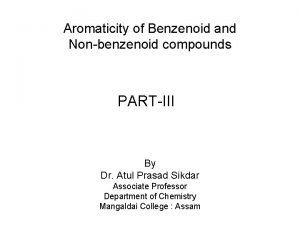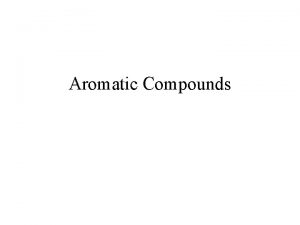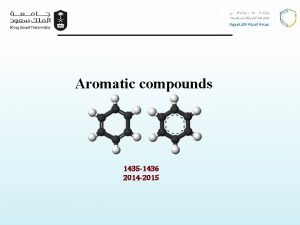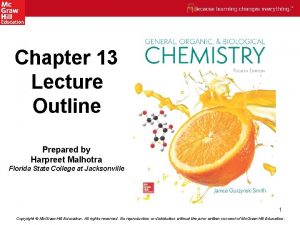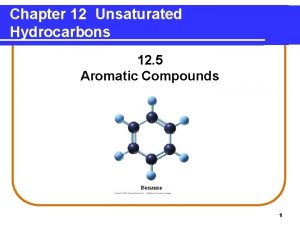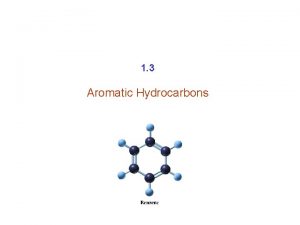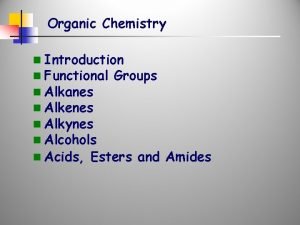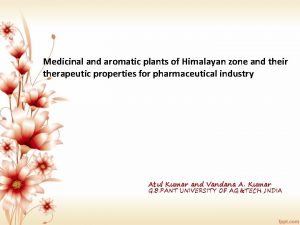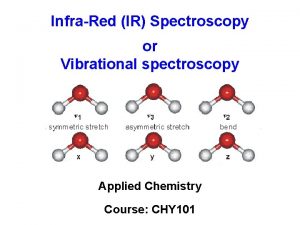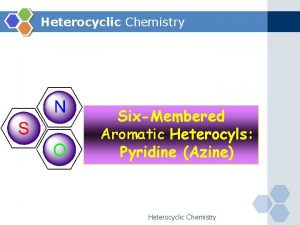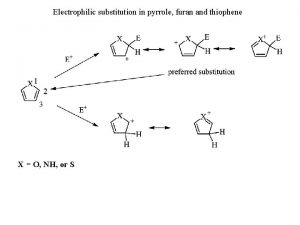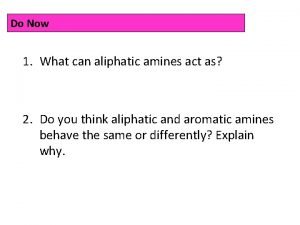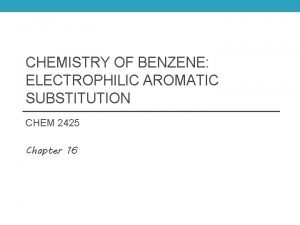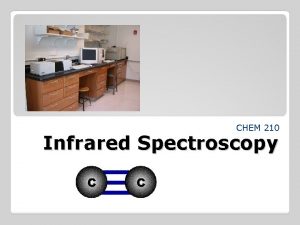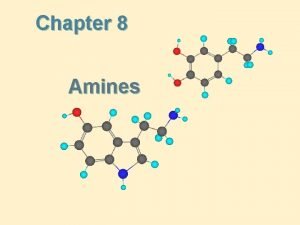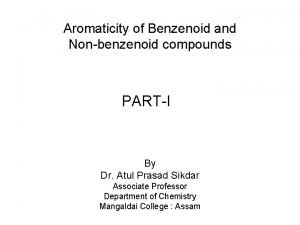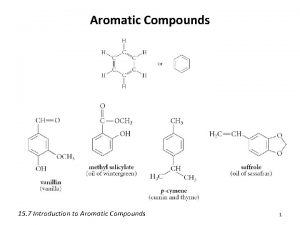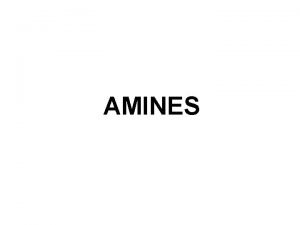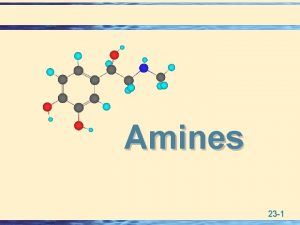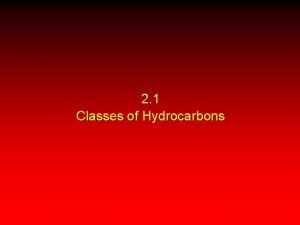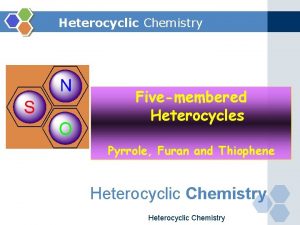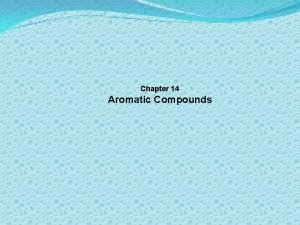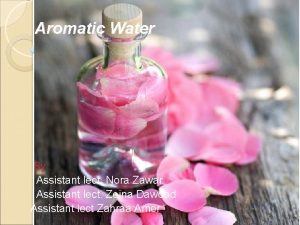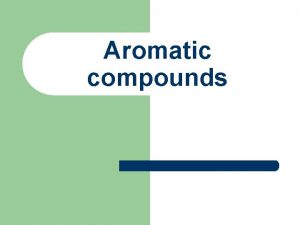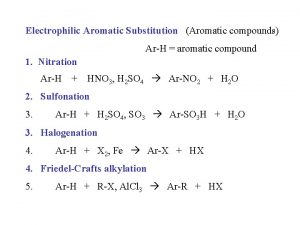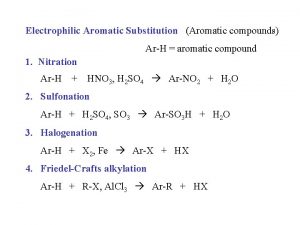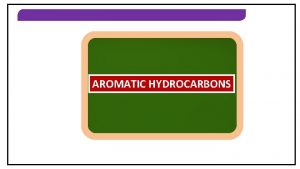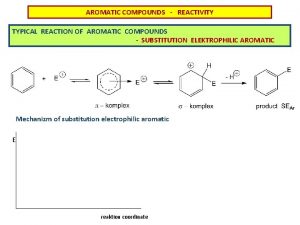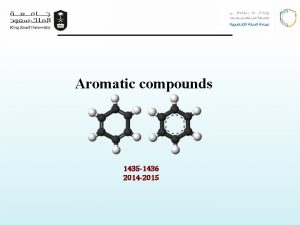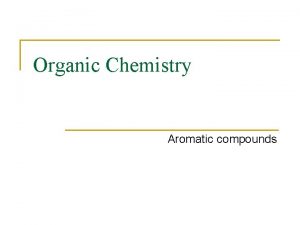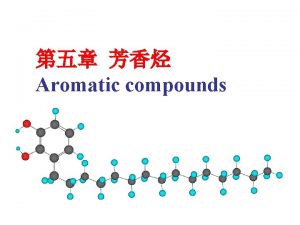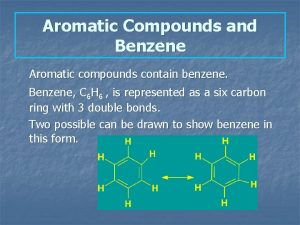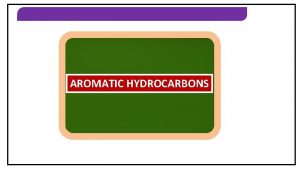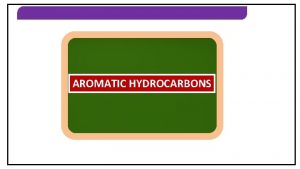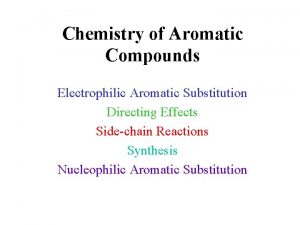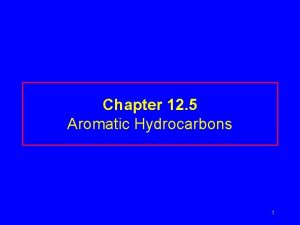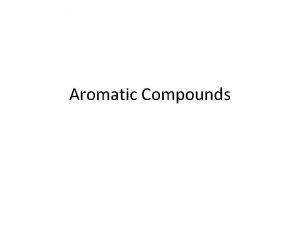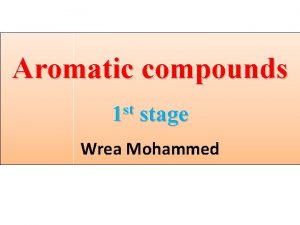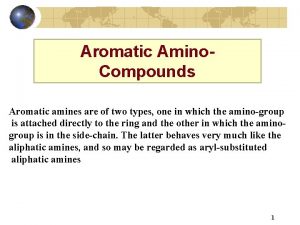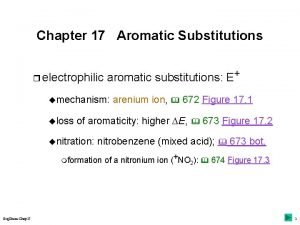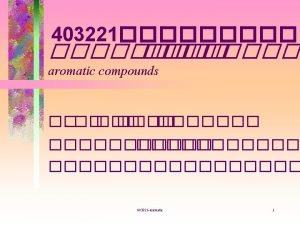Aromatic Compounds 15 7 Introduction to Aromatic Compounds





























- Slides: 29

Aromatic Compounds 15. 7 Introduction to Aromatic Compounds 1

Benzene, C 6 H 6, a Puzzling “Alkene” =CH 2 15. 7 Introduction to Aromatic Compounds 2

• Benzene is inert to typical reactions of ordinary alkenes – Halogen addition – Hydroboration – Hydration – Ozonolysis 3

15. 7 Introduction to Aromatic Compounds 4

Structure of Benzene 15. 7 Introduction to Aromatic Compounds 5

Comparison of Structures 15. 7 Introduction to Aromatic Compounds 6

The Benzene p System • Each carbon in benzene is trigonal planar and sp 2 hybridized • Hence, all of the p orbitals in benzene are parallel and readily overlap 15. 7 Introduction to Aromatic Compounds 7

8

Stability of Benzene • Benzene: DH°f = 82. 93 k. J/mol – 13. 8 k. J/mol per CH group • COT: DH°f = 298. 0 k. J/mol – 37. 3 k. J/mol per CH group • Therefore, benzene is 23. 5 k. J/mol (37. 3 -13. 8) more stable than COT per every CH group • Empirical resonance energy of benzene – (23. 5 k. J/mol) x 6 CH groups = 141 k. J/mol – Estimate of energy by which benzene is stabilized by resonance 9

Criteria for Aromaticity • Four structural criteria must be satisfied for a compound to be aromatic 1) A molecule must be cylic • Each p orbital must be connected with p orbitals on adjacent atoms Aromatic Benzene 15. 7 Introduction to Aromatic Compounds Not Aromatic 1, 3, 5 -hexatriene 10

2) A molecule must be planar • All adjacent p orbitals must be aligned so that the π electron density can be delocalized Benzene Cyclooctatetraene 11

3) The molecule must be completely conjugated • There must be a p orbital at every atom No p orbitals • Completely conjugated ring • A p orbital at every atom in the ring • Aromatic • 1, 3 -cyclohexadiene • Not completely conjugated • Not aromatic 12

4) A molecule must satisfy Hückel’s Rule – Hückel’s Rule: in order to be aromatic, a molecule must contain 4 n + 2 π electrons • n = 0, 1, 2 etc. – Molecules containing 4 n π electrons are antiaromatic • Often quite unstable • 6 π electrons • 4(1) + 2 = 6 • Aromatic • 4 π electrons • 4(1) = 4 • Aromatic 13

Hückel’s Rule Anti-aromatic Aromatic n 4 n 4 n + 2 0 0 2 1 4 6 2 8 10 3 12 14 4 16 18 • Note that Hückel’s Rule refers to the number of π electrons, not the number of atoms in the ring 14

Summary • Aromatic: cyclic, planar, completely conjugated compound with 4 n + 2 π electrons • Anti-aromatic: cyclic, planar, completely conjugated compound with 4 n π electrons • Non-aromatic: a compound that lacks one or more of the following requirements: being cyclic, planar, or completely conjugated. 15

Aromatic Heterocycles • Vinylic electrons • Electrons on doubly bonded atoms • Not included in π electron count • Allylic electrons • Electrons on atom next to a doubly bonded atom • Included in π electron count 16

Aromatic Ions 17

18

19

Polycyclic Aromatic Compounds • The Hückel 4 n+2 rule applies to single ring compounds however, many fused bicyclic and polycyclic compounds are also aromatic 15. 7 Introduction to Aromatic Compounds 20

21

Problems • Classify the following molecules as aromatic, anti-aromatic, or non-aromatic 22

23

Spectroscopy of Aromatic Compounds • Infrared Spectroscopy – Aromatic ring • C–H stretching at 3030 cm 1 • Two peaks at 1450 -1600 and 1660 -2000 cm 1 – Ordinary Alkene • C-H absorbance at 30203100 cm-1 • C=C at 1640 -1680 cm-1


26

• Ultraviolet spectroscopy – Intense peak near 200 nm and then less intense peaks closely after 27

• NMR – 1 H NMR: Aromatic H’s strongly deshielded by ring and absorb between 6. 5 and 8. 0 28

• Aromatic ring oriented perpendicular to a strong magnetic field – Delocalized electrons producing a small local magnetic field • Opposes applied field in middle of ring • Reinforces applied field outside of ring – Aromatic H’s experience greater effective mag field – Deshielded
 Examples of non aromatic compounds
Examples of non aromatic compounds What is n in huckel rule
What is n in huckel rule Non aromatic heterocyclic compounds
Non aromatic heterocyclic compounds Aromatic compounds huckel rule
Aromatic compounds huckel rule Non aromatic compounds
Non aromatic compounds Aromatic compounds undergo
Aromatic compounds undergo Unsaturated aromatic compounds
Unsaturated aromatic compounds Aromatic saturated or unsaturated
Aromatic saturated or unsaturated Ionic, covalent and metallic bonds venn diagram
Ionic, covalent and metallic bonds venn diagram Aromatic functional group
Aromatic functional group Define medicinal plants
Define medicinal plants Importance of aromatic plants
Importance of aromatic plants Infrared spectroscopy provides valuable information about *
Infrared spectroscopy provides valuable information about * Is pyridine aromatic
Is pyridine aromatic Electrophilic substitution in pyrrole
Electrophilic substitution in pyrrole Amines chemsheets
Amines chemsheets Aromatic electrophilic substitution mechanism
Aromatic electrophilic substitution mechanism Nitro group ir
Nitro group ir Aromatic amines structure
Aromatic amines structure Cycloheptatrienyl cation
Cycloheptatrienyl cation What is n in huckel rule
What is n in huckel rule Classify the following molecule
Classify the following molecule Aromatic amino acids
Aromatic amino acids Primary secondary amine
Primary secondary amine Basicity amines
Basicity amines Do aromatic amines give hinsberg test
Do aromatic amines give hinsberg test Aliphatic vs aromatic
Aliphatic vs aromatic Why is pyrrole aromatic
Why is pyrrole aromatic Halogenations
Halogenations Aromatic water preparation
Aromatic water preparation
